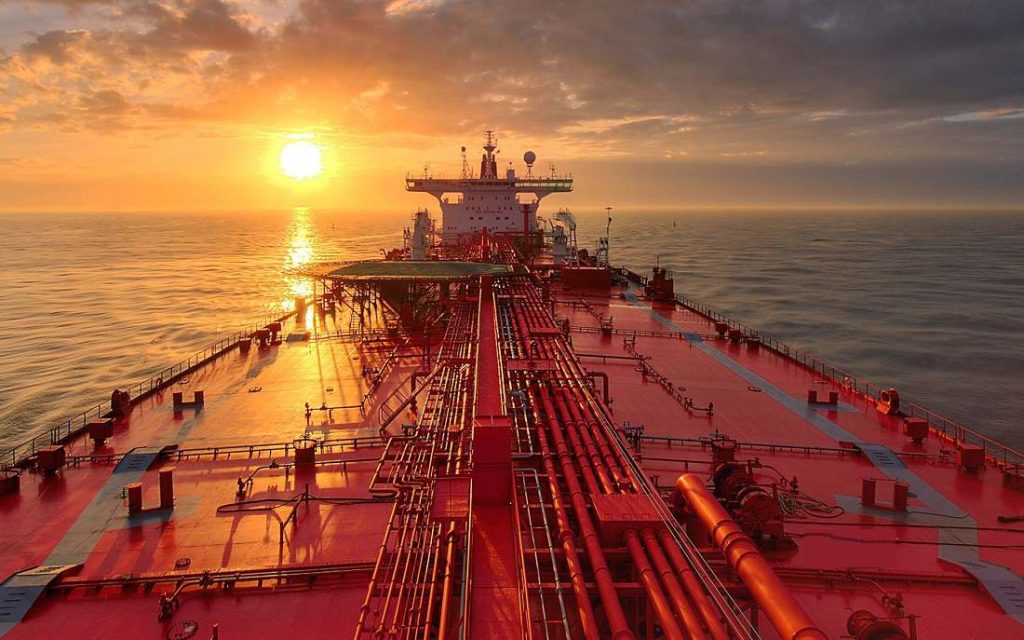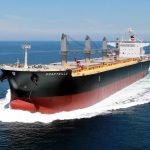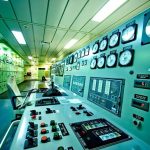Oil tankers

There are today more than 3,500 oil tankers in operation. They include the world’s largest ships, one of which (the Jahre Viking) can carry more than half a million tons of crude oil at a time. Many other tankers are almost as large. Yet as a ship type tankers are relatively new. As late as the middle of the 19th century the only oil transported in large quantities by sea was fuel for oil lamps. Most of this was fish, whale and vegetable oil, but in 1859 an unemployed railway conductor named Edwin Drake was hired to drill for mineral oil at Titusville, Pennsylvania. He struck oil at a depth of 21 metres on 28 August 1859 ‘ and in a sense the modern age began.
There are many different types of tanker, ranging from those carrying crude oil, through those built to transport various refined hydrocarbon products, to highly specialized ships that carry liquefied petroleum gas and natural gas. There are even tankers designed to carry cargoes such as fresh water, wine or orange juice. The first purpose built tanker was the Gluckauf, a 3,000 dwt vessel built in 1886. It had a steam engine and two masts. In size terms, the heyday of the tanker was the early 1970s, when the so-called Ultra-Large Crude Carriers (ULCCs), capable of lifting more than half a million tonnes of cargo, sailed the oceans.
After the oil crisis of the 70s, tanker owners became a little more modest in their ambitions and, since then, most large modern tankers are in the 200-300,000 tonnage range. These are still massive vessels and enormously expensive to build, but today’s high price of oil means they can pay for themselves in a relatively short period of time.
Classes and sizes:
Panamax : The largest size crude oil tanker that can travel through the Panama Canal: up to 70,000 DWT.
Aframax: Size of crude oil tanker which uses the Average Freight Rate Assessment (AFRA) method to calculate the cost of transportation: 70,000 to 120,000 DWT.
Suezmax: largest size crude oil tanker that can travel through the Suez Canal while Loaded: 120,000 – 200,000 DWT.
Very Large Crude Carrier (VLCC): Size of a large crude oil carrier (200,000-325,000DWT)
The world’s largest ship was a 564,765 dwt tanker with a length overall of 458.45m (1,504ft); She was longer than many of the world’s tallest buildings with an interesting and varied history. Built in 1976 and having undergone some work to increase her load-carrying capacity, she was finally floated two years later and named Seawise Giant. At first, she operated in the Gulf of Mexico and the Caribbean Sea, but was then used for exporting oil from Iran during the Iran-Iraq War. In 1986, she was attacked but not sunk in the Strait of Hormuz and at the end of the war in 1989 she was repaired and renamed Happy Giant. In 1991, she was renamed again, this time to Jahre Viking. In March 2004, the ship was sold and sent by its new owner to be refitted as a floating storage and offloading unit. There, she was renamed Knock Nevis and she operated in the Al Shaheen oilfield in the waters of Qatar until 2010 when, renamed Mont, she was delivered for breaking up at Gujarat’s Alang-Sosiya shipyard in India.
Chemical tankers

Many of the changes in everyday life that have taken place during the last fifty years have resulted from developments in the chemical industry. A wide range of ordinary items are in fact derived from complex chemical processes, and are often derived from the by-products of the production of energy. Some perfumes and medicines are derived from coal: from oil and gases we obtain fertilizers and plastics, weed killers and detergents, clothing and paints. The greatest advances made in the chemical industry have been made in the last 25 years and one result has been a rise in the demand for raw materials. This in turn has led to a great increase in the maritime transportation of chemicals and the development of specialized ships in which to carry them. The ships that have been built in response to this demand are among the most complex ever constructed. The cargoes they carry often present tremendous challenges and difficulties from a safety point of view and many chemicals are also a far greater pollution threat than crude oil.
Passenger ships

In 1950 passenger ships were the largest, fastest and most glamorous vessels afloat. The trans-Atlantic route between Europe and North America was the most prestigious route of all with great liners competing for the fastest crossing ‘ the Blue Riband. Other passenger services operated between Europe and South America, South Africa, Australia and New Zealand and were used in particular by emigrants leaving post-war Europe for a new life on the other side of the world.
Passenger Ships Today
There are two basic categories – which can be summed up as fun or function. In the latter category are those which are designed to move people and, often, vehicles on regular itineraries from one place to another as quickly and cheaply as possible (ie ferries) and, in the former, those which the passengers see as a leisure destination in their own right (ie cruise ships).
Ferries range from small passenger ferries crossing rivers such as the River Hudson or Norwegian fjords, to big Ro-Ro (Roll-on Roll-off) ferries with a capacity to carry 3000 passengers and 650 cars such as those operating across the English Channel. In both categories, the size, sophistication and the sheer number of passengers that can be carried have reached mind-boggling proportions.
Because of their individuality, as well as their resonance with the great ocean liners of a bygone era, these ships tend to be the best known and most recognized among the general public at large.
One of the finest modern examples is the world’s largest cruiseship Oasis of the Seas delivered by STX Europe’s Turku shipyard in Finland for Royal Caribbean International in 2009. 13 A true maritime giant, her capacity of 6,360 passengers plus some 2,100 crew is quite astonishing, and, with a gross tonnage of 225,000 tons, makes her the largest passenger ship afloat. It is difficult to find the words to aptly describe such a feat of naval architecture, shipbuilding and marine engineering; but monumental and awesome spring to mind. She incorporates all the very latest international standards with regard to safety, security and environmental protection, offering her passengers an unparalleled opportunity to experience the wonders of ocean travel in the finest style. Her sistership, the Allure of the Sea was delivered at the end of 2010.
Despite the economic downturn, which has clearly had a negative impact on revenues throughout the leisure market, the Cruise Lines Industry Association reports that the 13.44 million people, who cruised in 2009, represented a 4.8 per cent increase on 2008, a strong sign of continuing consumer interest and demand. It seems, therefore, that the cruise and passenger sector remains one of the shipping industry’s more vibrant, witnessing substantial growth on all fronts – numbers of passengers, numbers of ships, new destinations and ship sizes.
Roll-on/roll-off ships

The modern roll-on/roll-off ship can trace its origins back more than one hundred years to the early days of the steam train. Ships were specially designed to take trains across rivers which were too wide for bridges: the ships were equipped with rails, and the trains simply rolled straight on to the ship, which sailed across the river to another rail berth where the train would roll off again. An example is the Firth of Forth ferry in Scotland, which began operations in 1851. It was not until the Second World War, however, that the idea of applying the ro-ro principle of road transport became practicable – and was used in constructing the tank landing craft used at D-Day and in other battles. The principle was applied to merchant ships in the late 1940s and early 1950s. It proved to be extremely popular, especially on short-sea ferry routes, encouraged by technical developments on land as well as sea, notably the increase in road transport.
Roll-on/roll-off ships Today
The roll-on/roll-off ship is one of the most successful types operating today. Its flexibility, ability to integrate with other transport systems and speed of operation have made it extremely popular on many shipping routes. The roll-on/roll-off ship is defined in the November 1995 amendments to Chapter II-1 of the International Convention for the Safety of Life at Sea (SOLAS), 1974 as being “a passenger ship with ro-ro cargo spaces or special category spaces…” One of the ro-ro ship’s most important roles is as a passenger/car ferry, particularly on short-sea routes. According to ShipPax, in 2004, more than 1.3 billion pasengers, 188 million cars, 856,000 buses and 28.7 million trailers were carried on 5.9 million crossings globally. The total number of ferries worldwide at 1 January 2006 (excluding ferries less thaan 1,000 gross tonnage) was 1,162, with a combined capacity of 1.15 million passengers and 226,210 cars or 769,210 lanemetres of commercial vehicles. Combined gross tonnage was 12.8 million and the average age of the fleet was 21 years. But despite its commercial success, there have been disturbing accidents involving different types of ro-ro ship, the worst being the sudden and catastrophic capsizing of the passenger/car ferry Herald of Free Enterprise in March 1987 and the even more tragic loss of the Estonia in September 1994.



Comments are closed